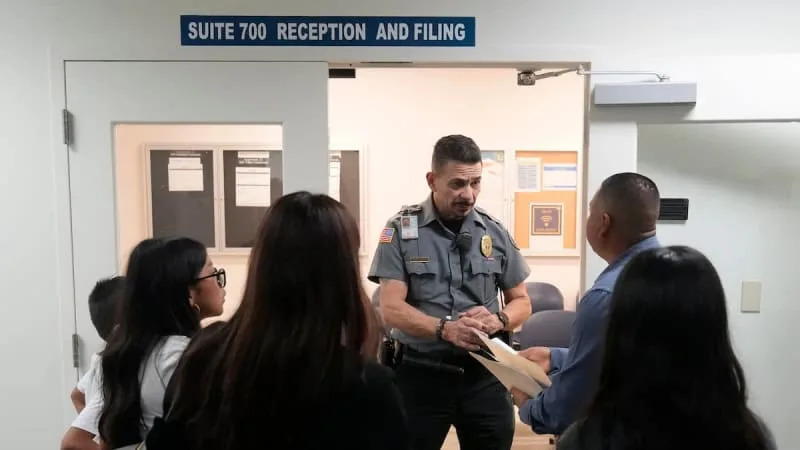
Florida has been a top partner in executing President Donald Trump’s deportation agenda — finding and detaining people who are in the country illegally.
Florida also leads in what has become a nationwide problem: a massive backlog in immigration court cases that determine whether an immigrant can stay in the country.
More cases are waiting to be heard in Florida‘s immigration courts than in any other state, according to data compiled by Syracuse University. It’s a long-standing problem wherein cases have piled up over the years in front of a shortage of judges.
But it’s being accelerated in part as Gov. Ron DeSantis’ administration has pushed to be at the fore of executing Trump’s mass deportation agenda. Florida leads the U.S. in the number of state and local law enforcement agencies that have signed agreements with the federal government that allow them to detain immigrants in the country illegally.
The upshot isan increasingly strained immigration court system so overloaded thatformer judges and advocate groups say people aren’t getting due process.
Trump, who in the past has questioned the need for due process for such immigrants, has ramped up detention efforts but has not staffed or funded immigration courts with the same zeal.
But thearm of the U.S. Justice Department thatoperates the courts said reducing the backlog is itshighest priority.
Spokesperson Kathryn Mattingly wrote in an email thatthe Executive Office of Immigration Review at the Department of Justice “will continue to use all of its resources to adjudicate immigration cases fairly, expeditiously, and uniformly consistent with due process.” She said the pending caseload has fallen by more than 391,000 cases since the start of the second Trump administration. That is about 12% of the total number of pending cases.
Still,the average wait for immigrants to have their cases heard in courtis four years.
With more than a quarter of the year to go, the more than 520,000 pending cases in Florida’s courts in Orlando, Miami and the Krome detention center in Miami-Dade County are nearing the level of backlogged cases from the entire prior year. If cases accumulate at the same rate, the state is on track to nearly double the total number of immigration cases awaiting review by January.
Miami’s docket eclipses the next highest backlogged docket, in Chicago, by more than 37,000 cases, according to data from Syracuse University.
Florida has led the country in backlogged cases since 2022. But the margin by which it has led other states, including second-highestTexas, is growing.
“If you keep adding detainees and you don’t add judges, that four years is going to become six years is going to become eight years, because you’re just adding that many more people who have to go through the immigration (court) system,” said Pinellas County Sheriff Bob Gualtieri, who serves on Florida’s State Immigration Enforcement Council. The Pinellas County Jail, like every other jail in the state, works with U.S. Immigration and Customs Enforcement to temporarily hold immigrant detainees before they are transported to ICE detention centers.
The Trump administration has said it wants to roughly double the space it has nationwide to detain migrants. But it has not proposed increases of that scope on the judicial side.
“They (have) got to unclog it someplace, because you can’t keep filling the boat with water,”Gualtieri said. “Eventually, the boat sinks.”
Sinking the boat
Trump and his top advisers have floated a solution to the backlog: reducing or eliminating due process for those in the country illegally.
“We cannot give everyone a trial, because to do so would take, without exaggeration, 200 years,” Trump wrote on social media in April. His border czar, Thomas D. Homan, also questioned the need for due process that month.
A dysfunctional court system with a huge backlog of cases helps him make that argument, say some former federal immigration judges and immigration legal experts. So does removing judges in the midst of a shortage, they say.
Attorney General Pam Bondi has fired more than 100 immigration court judges since February without citing a reason.
When immigration judges can be fired at any time with no civil service protection or recourse available, their power is neutered, said Ashley Tabaddor, a former Los Angeles immigration judge and former president of the National Association of Immigration Judges. Tabaddor also served in the Biden administration as a lawyer in the Department of Homeland Security.
“You’re removing the defining element of a court,” she said.
Jennifer Peyton was fired by email in July from her job as the assistant chief immigration judge for Chicago’s immigration court.She said no reason was given.
“I think they are trying to intentionally defund (the courts) so they can say it’s not working and the backlog is too big,” said Peyton, who served as an immigration judge for 15 years under both Republican and Democratic presidents.
Mattingly, the Justice Department immigration court spokeswoman, said the agency “declines to comment on personnel matters” about why the agency has fired judges but noted that it is posting vacancies online and hiring immigration judges, including in Florida. She did not specify how many Florida vacancies exist, and the Justice Department site did not list any openings in the state as of Wednesday.
The One Beautiful Bill Act, passed in July, provides $3.3 billion for the Department of Justice and the Executive Office of Immigration Review, which houses immigration courts. But the law doesn’t specify how it should be spent or direct officials to hire judges or expand the court’s functions.
The law caps the number of additional immigration judges that can be hired at 800 starting in November 2028. Though the cap doesn’t take effect for three years, the American Immigration Council, a national immigration advocacy group, said it will hamper progress on reducing the backlog.
As of June 30, 685 immigration judges werepresiding over the backlog of about 3.4 million cases nationwide,according to the Department of Justice. That is roughly 5,000 cases per judge.
Tabaddor said it would take about 2,500 to 3,000 additional immigration judges, as well as more administrative staff, law clerks, interpreters and others, to make a meaningful dent in the backlog and also process new cases.
“Building that kind of capacity is not easy, nor can it be done overnight,” Tabaddor said.
Earlier this month, the Justice Department issued a memo requiring immigration judges to issue decisions within 10 days of a final hearing date for casesin which the immigrant in question is detained and within 60 days in cases in which the immigrant is not in custody.
Suchrules may seemingly work to reduce the backlog but do the opposite becausethey restrict the court’s ability to adjudicate cases efficiently and fairly, Tabaddor said.
“Cases are not some factory construction,” she said.
Flexibility is crucial for efficiency and to meet the needs of each case, she said.
In Florida, DeSantis has offered to deputize military lawyers in the National Guard to act as immigration judges, a plan Trump has approved.
The state has not yet received a request for Guard support, said Florida National Guard spokeswoman Capt. Brittianie Funderburk. If the federal government decides to activate guard attorneys to work as immigration judges, the “federal authorities would provide any necessary training and would also determine the work they’re doing as well as work locations,” she said.
Funderburk said there are nine suchjudge advocates general eligible for that duty.That’s far short of what would be needed to meaningfully make a dent in the caseload.
If reducing the backlog was the goal, there are other ways to do it, including simplifying asylum applications for obvious cases, said Denise Gilman, a law professor at the University of Texas at Austinwho directs its immigration clinic.
“The most logical response would be to streamline asylum grants to get them situated …without wasting immigration courts’ resources," she said.
That way, courts would be freed up to adjudicate non-asylum cases.
But, she said, that’snot the choice being made by the Trump administration.
Katelyn Ferral is a politics reporter. Contact her at [email protected].
How does immigration court work?
The immigration court system is different and separate from civil or criminal courts. Here’s what to know.
The country’s immigration court system has had several iterations since it was first established in 1891 but was most recently overhauled in 1983. That year, the Executive Office of Immigration Review was created under the U.S. Department of Justice to hear immigration cases. This is the agency that hears immigration cases today.
The goal was to give immigration courts some independence by separating it from the enforcement and detainment part of the federal government.
Today, enforcement lies within the Department of Homeland Security and is administered through ICE and Customs and Border Patrol.
An immigration court case is first initiated when an immigrant in the country illegally gets a “notice to appear” in the immigration court closest to where they live. The case is scheduled for its first set of hearings, in which a judge determines whether the immigrant is subject to removal.
During these hearings, the immigrantmay apply for and be approved for a form of immigration protection. These could include asylum because of persecution in their home country, or temporary protected status, where an immigrant’s country is considered unsafe.
After submitting an application for protection from deportation, an immigration judge and an attorney for the federal government hear evidence about the immigrant’s situation.
The immigration judge will then approve or deny the immigrant’s request to stay.
Either the immigrant or the federal attorney arguing for deportation can appeal the judge’s decision, kicking off a separate process ultimately decided by the Board of Immigration Appeals, also part of the Justice Department.
Estimates of how frequently an appeals claim is successful varies, but plaintiffs’ attorneys estimate the board reverses a judge’s decision in 10% to 20% of cases.








Comments